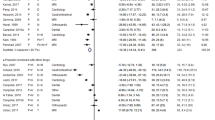Abstract
Although ketamine has been used for procedural sedation and analgesia, some researchers have assessed ketamine–propofol as a better alternative because of its reduced adverse events. The goal of this review was to compare adverse events between ketamine–propofol and ketamine for procedural sedation and analgesia in children. We searched the literature from their inception to May 2018 without the restriction of language. We included all randomized controlled trials comparing ketamine–propofol with ketamine for procedural sedation and analgesia in children. The meta-analysis was conducted using the Stata software. A total of six studies involving 693 individuals were included. Pooling of data showed that subjects with ketamine–propofol had similar incidence of respiratory adverse events compared to those with ketamine (RR 1.16, 95% CI 0.68–1.98). However, ketamine–propofol was effective in reducing cardiovascular adverse events compared to ketamine (RR 0.11, 95% CI 0.04–0.31). Ketamine–propofol was also effective in reducing psychomimetic adverse events compared to ketamine (RR 0.39, 95% CI 0.16–0.93). In regard to nausea and vomiting, ketamine–propofol was significantly effective (RR 0.43, 95% CI 0.25–0.74). In addition, we could not demonstrate differences in efficacious sedation between ketamine–propofol and ketamine. Although our study was not able to demonstrate differences in efficacious sedation between ketamine–propofol and ketamine, we confirmed that ketamine–propofol sedation had a lower frequency of adverse events compared to ketamine sedation in children.





Similar content being viewed by others
References
Chawla N, Boateng A, Deshpande R (2017) Procedural sedation in the ICU and emergency department. Curr Opin Anesthesio 30(4):507–512
Johnson OG, Taylor DMD, Lee M et al (2017) Patient satisfaction with procedural sedation in the emergency department. Emerg Med Australas 29(3):303–309
Miner JR, Driver BE, Moore JC et al (2017) Randomized clinical trial of propofol versus alfentanil for moderate procedural sedation in the emergency department. Am J Emerg Med 35(10):1451–1456
Weisz K, Bajaj L, Deakyne SJ et al (2017) Adverse events during a randomized trial of ketamine versus co-administration of ketamine and propofol for procedural sedation in a pediatric emergency department. J Emerg Med 53(1):1–9
Lameijer H, Sikkema YT, Pol A et al (2017) Propofol versus midazolam for procedural sedation in the emergency department: A study on efficacy and safety. Am J Emerg Med 35(5):692–696
Costi D, Ellwood J, Wallace A et al (2015) Transition to propofol after sevoflurane anesthesia to prevent emergence agitation: a randomized controlled trial. Pediatr Anaesth 25(5):517–523
Kidd LR, Lyons SC, Lloyd G (2016) Paediatric procedural sedation using ketamine in a UK emergency department: a 7 year review of practice. Brit J Anaesth 116(4):518–523
Hopper AB, Vilke GM, Castillo EM et al (2015) Ketamine use for acute agitation in the emergency department. J Emerg Med 48(6):712–719
Shah A, Mosdossy G, McLeod S et al (2011) A blinded, randomized controlled trial to evaluate ketamine/propofol versus ketamine alone for procedural sedation in children. Ann Emerg Med 57(5):425–433
Canpolat DG, Yildirim MD, Aksu R et al (2016) Intravenous ketamine, propofol and propofol-ketamine combination used for pediatric dental sedation: a randomized clinical study. Pak J Med Sci 32(3):682–687
Kinsara AF, Almehmadi AAM, Abdulmajid TJ et al (2017) A study to evaluate KM/propofol versus KM alone for procedural sedation in children. Egypt J Hosp Med 69(8):2981–2985
Stevic M, Ristic N, Budic I et al (2017) Comparison of ketamine and ketofol for deep sedation and analgesia in children undergoing laser procedure. Laser Med Sci 32(7):1525–1533
Yalçın G, Öztaş N, Kip G (2018) Evaluation of clinical effectiveness of three different sedation protocols (intravenous propofol vs. ketamine vs. ketofol) in anxious children. Anaesth Pain Intens Care 22(1): 16–25.
Sherlin K, Wiedmar J, Shoff H et al (2018) Hemodynamic changes during procedural sedation with ketofol in the emergency department. Crit Care Med 46(1):436–438
Sanri E, Karacabey S, Akoglu H et al (2017) Comparison of ketamine/propofol (ketofol) and etomidate/fentanyl (etofen) combinations for procedural sedation and analgesia in the emergency department: an observational study. Turk J Emerg Med 17(3):89–94
Júnior M, Moreira F, Mattos RV et al (2015) Chronic pain relief after the exposure of nitrous oxide during dental treatment: longitudinal retrospective study. Arq Neuro-psiquiat 73(7):578–581
Roth JV (2018) Chronic pain and the opioid epidemic: are we ignoring the potential benefits of nitrous oxide? Anesth Analg 126(4):1423–1424
Acknowledgements
The authors would like to thank Dr Shuizhen Hua and Hairong Liao for assisting with managing and obtaining references.
Funding
None.
Author information
Authors and Affiliations
Corresponding author
Ethics declarations
Conflict of interests
None declared.
Statement of human and animal rights
All procedures performed in this study are in accordance with ethical standards of the institutional and national research committee and with the 1964 Helsinki declaration and its later amendments or comparable ethical standards.
Informed consent
For this study, informed consent was not required.
Additional information
Publisher's Note
Springer Nature remains neutral with regard to jurisdictional claims in published maps and institutional affiliations.
Rights and permissions
About this article
Cite this article
Hu, Y., Xu, W. & Cao, F. A meta-analysis of randomized controlled trials: combination of ketamine and propofol versus ketamine alone for procedural sedation and analgesia in children. Intern Emerg Med 14, 1159–1165 (2019). https://doi.org/10.1007/s11739-019-02173-6
Received:
Accepted:
Published:
Issue Date:
DOI: https://doi.org/10.1007/s11739-019-02173-6




